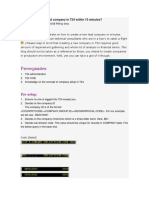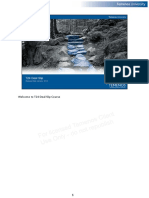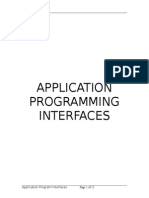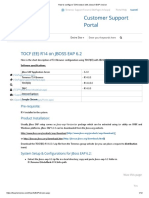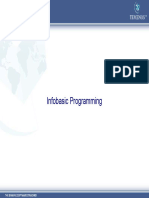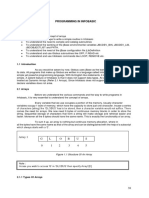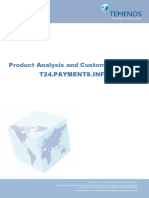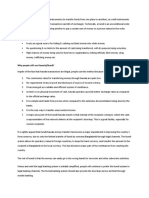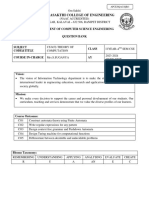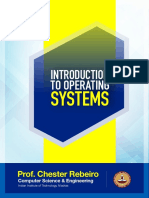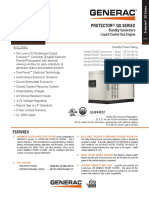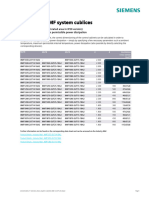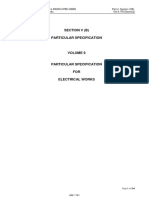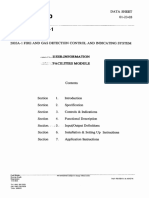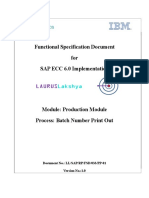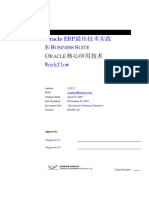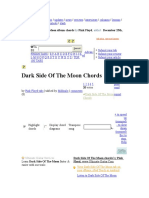Infobasic Programming
Agenda
Introduction to Infobasic
Arrays and types of arrays
Introduction to subroutines and programs
Important functions/commands in Infobasic
Steps to create a subroutine in T24
Compiling and cataloguing routines and programs
T24 routines – file operations
T24 routines – sequential file access
T24 – Creation of functions and routines with arguments
Introduction To Infobasic
Programming language used for T24
Simple – English like statements
No declaration of variables required
No data type specification is required
All variables by default have infinite variable length
Multi value
Sub Value
Arrays
Continuous allocation of bytes
All bytes in an array have the same name as that of the array
Each byte is uniquely identified with the help of a subscript.
Arrays In Infobasic
Dynamic Arrays
Dynamic in nature
Variable length
Need not be declared
Can hold any type of data
Automatically increase or decrease in size depending on the data
All variables in Infobasic are dynamic arrays
Dimensioned arrays
Have a fixed number of rows and columns
Can hold any type of data
Needs to be declared
Used when dimensions and extents are known and are not likely to
change
Dynamic Array
CUSTOMER.NAME = ‘’
RATE = 0
DATE = “121202”
Can store any type and any amount of data.
Only initialisation is required.
Arrays
Dynamic Arrays (Cont.)
Uses delimiters to store data of various fields
ASCII Decimal Description
254 Field Marker
253 Value Marker
252 Sub-Value Marker
Sample Record From The TEMENOS.TRG
How will this record get stored in a dynamic array?
Storage In A Dynamic Array
TemenosTrgFMIndiaVMUKVMGenevaFMTechnicalVMFunctionalF
M
jBASESMT24VMLendingSMFinancialsFMFMTrainer.1
Structure Of An Infobasic Program
PROGRAM – Executed from the database prompt
SUBROUTINE – Execute from within Globus
*Comments *Comments
PROGRAM <Programname> SUBROUTINE <Subroutinename>
Statement 1 Statement 1
Statement 2 Statement 2
Statement 3 Statement 3
RETURN
END END
Compiling And Cataloguing Routines
Executing Routines
Executing Programs
Writing A Simple Infobasic Program
Program to display ‘Hello World’
JED TRG.BP HELLO
PROGRAM HELLO
CRT “Hello World”
END
Compile And Execute The Program
Compile and catalog
EB.COMPILE TRG.BP HELLO
Execute the program
jsh..>HELLO
Hello World
SUBROUTINES WITH PARAMETERS
• Subroutines can take In Parameters and Return the values as well.
• Example: F.READ
This Subroutine has five parameters out of which
File name, record id and File Pointer are incoming parameters.
Recordvar, Errorvar are Return values
SUBROUTINES WITH PARAMETERS
Example:
Step 1:
Create a routine that accepts two values and returns the multiplication of two
values in variable.
SUBROUTINE TEST.CALLED.RTN(A,B,C)
C=A*B
RETURN
END
SUBROUTINES WITH PARAMETERS
Step 2: Create another routine that supplies the two values and prints the result.
PROGRAM TEST.CALLING.RTN
A = 10 ; B =20
CALL TEST.CALLED.RTN(A,B,RESULT)
PRINT “RESULT : ”:RESULT
END
Step 3: Compile and catalog the Program and Subroutine.
Step 4:
Run the Program
Result : RESULT : 200
PATH
Contains a list of all directories that has executable programs.
Typically, PATH is already set to locate system and other
application executables (like C, java, etc)
Add paths for jBASE and user executables
User executables are your cataloged programs for the Globus
application
PATH - Contd
Unix
PATH=$PATH:/apps/bin
export PATH
Windows
SET PATH=%PATH%;D:\
PATH=%PATH%;D:\apps
apps\\bin
JBCOBJECTLIST
Shows Search path of user subroutines
This is used during program execution
Unix
JBCOBJECTLIST=$HOME/lib:/home/TESTBASE/lib
export JBCOBJECTLIST
Windows
SET JBCOBJECTLIST=%HOME%\
JBCOBJECTLIST=%HOME%\lib;C:
lib;C:\\dev
dev\\TESTBASE
TESTBASE\\lib
JBCDEV_BIN AND JBCDEV_LIB
Define where the locally developed executables and libraries
are stored (when cataloged)
Tell jBASE where to put your cataloged programs and
subroutines
These paths should be included in your PATH and
JBCOBJECTLIST for your programs to be used.
JBCDEV_BIN AND JBCDEV_LIB
export JBCDEV_BIN=$HOME/bin
export JBCDEV_LIB=$HOME/lib
Control Structures
The various Control structures are
• IF-THEN-ELSE Structure
• CASE Structure
• FOR-NEXT Structure
• LOOP-REPEAT Structure
Control Structures
IF THEN ELSE
IF expression THEN
statements
END ELSE
IF expression THEN
statements
END ELSE
statements
END
END
IF THEN ELSE - EXAMPLE
A=2
IF A > 10 THEN
PRINT “GIVEN NUMBER IS GT 10”
END ELSE
IF A 5 THEN
PRINT “INPUT IS GT THAN 5 AND LE 10”
END ELSE
PRINT “INPUT GIVEN IS LT 5”
END
END
RESULT : INPUT GIVEN IS LT 5
Control Structures
BEGIN CASE … END CASE
BEGIN CASE
CASE <variable> = <value>
<statements>
CASE <variable> = <value>
<statements>
CASE <variable> = <value>
<statements>
CASE 1
<statements>
END CASE
BEGIN CASE … END CASE
Expressions/statements evaluated in sequential order.
• when a true expression is encountered, the corresponding
statements
are executed and control exits from the CASE structure.
• when no true expression is encountered, then the
statements under CASE 1 are executed and control exits
from the CASE structure.
• when no true expression is encountered, and in the
absence of CASE 1 expression, then no statements are
executed and control exits from the CASE structure.
CASE Structure
CASE Structure - Example
PROGRAM TEST4
NAME="MICHAEL"
BEGIN CASE
CASE NAME[1,2]='DA'
PRINT NAME
CASE NAME[1,2]='RI'
PRINT NAME
CASE NAME[1,2]='BA'
PRINT NAME
CASE 1
PRINT 'NO MATCH'
END CASE
END
Output : No Match
Control Structures
FOR
FOR - NEXT Structure
• Facilitates repeated execution of a set of statements.
• Control exits from structure after pre-determined number of
executions.
FOR <variable> = <initialvalue> TO <maximumvalue>
<statements>
NEXT <variablename>
Control Structures
FOR - NEXT Structure- Example
FOR I = 1 TO 10
PRINT ‘Counter Variable:’: I
NEXT
I is the counter variable.
The PRINT statement executes for a pre-determined 10 times (i.e) till the value of I is 10
Control Structures
Output:
COUNTER VARIABLE:1
COUNTER VARIABLE:2
COUNTER VARIABLE:3
COUNTER VARIABLE:4
COUNTER VARIABLE:5
COUNTER VARIABLE:6
COUNTER VARIABLE:7
COUNTER VARIABLE:8
COUNTER VARIABLE:9
COUNTER VARIABLE:10
Control Structures
FOR - NEXT Structure- Example
FOR I = 1 TO 10 STEP 2
PRINT ‘Counter Variable:’: I
NEXT
I is the counter variable.
The PRINT statement executes for a pre-determined 5 times, I being incremented by two
each time.
Output :
COUNTER VARIABLE:1
COUNTER VARIABLE:3
COUNTER VARIABLE:5
COUNTER VARIABLE:7
COUNTER VARIABLE:9
Control Structures
LOOP - REPEAT Structure
Facilitates repeated execution of a set of statements. Control
exits from structure when WHILE expression evaluates to false
or UNTIL expression evaluates to true.
SYNTAX
LOOP
set of statements
WHILE/UNTIL expression
set of statements
REPEAT
Control Structures
LOOP - REPEAT Structure - Example Output :
X= 0
PROGRAM TEST2
X= 1
X=0
X= 2
LOOP
X= 3
UNTIL X>4 DO
X= 4
PRINT "X= “ :X
X=X+1
REPEAT
END
Other Flow Control Statements
EXIT - exit from loop structure prematurely.
END - mandatory last statement in a program. Signifies end of program.
STOP - terminates execution of program and the control
transfers back to the process that invoked the program.
CALL - executes an external subroutine.
EXECUTE - executes unix / jBase commands.
GOSUB - transfer the control of the program to an internal subroutine available
within the program.
RETURN - used in conjunction with GOSUB. Transfers the control from the
subroutine back to the next statement after GOSUB in the main program.
GOTO - transfers control of the program to a statement within the program.
The control does not transfer back even when a return statement is
encountered.
Relational Operators
compare numeric, character string, or logical data.
result of the comparison, either true (1) or false (0), can be used to make a decision
regarding program flow.
relational operators are
EQ or = Equal to
NE or # >< <> Not Equal to
LT or < Less than
GT or > Greater than
LE or <= =< Less than or equal to
GE or >= => Greater than or equal to
Logical Operators
They are operators that combine two or more relational expressions.Logical operators
in info Basic are
AND
OR
NOT
Example
IF EMP.DESG EQ ‘MGR’ AND EMP.SAL GT 10000 THEN In the logical expression
above, the logical operator ‘AND’ combines the two relational expressions ‘EQ’ and
‘GT’.
Basic Commands
Compiler Directives
$INSERT - Inserts and compiles info Basic source code from another
program into the program being compiled
REM - Identifies a line as a comment line. Same as the
*, !, and $* signs
SUBROUTINE - Identifies a series of statements as a subroutine.
Built In Infobasic Functions
LEN(e) Length of the text in expression
COUNT(e,d) Number of occurrences of d in e
DCOUNT(e,d) Number of occurrences of d in e, +1
UPCASE(e) Converts e to uppercase
DOWNCASE(e) Converts e to lowercase
CHANGE(e,d,c) Change occurrences of d to c in e
OCONV(e,d) Convert e into the format specified
in d
Functions in Infobasic
under jBase
Accepting Data
INPUT
To Accept a Value for a Variable From User
SYNTAX :
INPUT VARIABLE, LENGTH
EXAMPLE
1. INPUT NAME,10
2. INPUT @(10,5):N,10
PROMPT
Used to change the prompt character displayed at the use of
INPUT Statement.
SYNTAX :
PROMPT expr
Example :
PROMPT “#”
DATA
Used to accept data if the response to a INPUT statement
is to be given without entering.
SYNTAX : DATA expr1,expr2
Example : A = 10 ; B = 22
DATA A,B
INPUT NO.OF.TRAINEES
INPUT AVG.AGE
DISPLAY Commands
CRT
Used to place Text & Data on the terminal
SYNTAX :
CRT @(COLUMN,ROW): TEXT / VARIABLE
Example : CRT A,B,C
CRT @(10,5): “AMERICAN EXPRESS BANK”
PRINT
This statement is used to print the value of a variable or text. Can be
used in conjunction with INPUT statement to prompt the user for input.
SYNTAX :
PRINT @(COLUMN,ROW): TEXT / VARIABLE
Example :
PRINT @(10,12):A,B
PRINT @(10,12): “ENTER THE NAME”:
INPUT NAME,12
LOCATE
Used to search a string in a dynamic array and get its position. Returns the field
Position only.
SYNTAX :
LOCATE <string> IN <array> {<field pos,multivalue pos>} SETTING <var>
THEN/ELSE <statements>
Example :
Y.ARRAY = 'KALLIS':@FM:'JONTY':@VM:'NICKY‘
LOCATE ‘KALLIS’ IN Y.ARRAY<2,1> SETTING POS ELSE NULL
RESULT: 2
STRING Manipulation
TRIMF Removes leading spaces from a string.
SYNTAX TRIMF(string)
TRIMB Removes trailing spaces from a string.
SYNTAX TRIMB(string)
TRIM Removes both leading &trailing spaces
SYNTAX TRIM(string)
LEN
Returns the number of Characters in a string
SYNTAX : LEN(string)
Example :
CRT LEN(“TEMENOS”)
Output : 7
FIELD
Extracts a sub-string from a Character string using delimiters.
SYNTAX : FIELD(string,delimiter,occur,fields )
Example : 1
X = “A/B/C/D”
Y = FIELD(X,”/”,2,2)
RESULT : Y has a value of B/C
Example : 2
X = “1-2-3-4-5-6”
Y = FIELD(X,”-”,3,2)
RESULT : Y has a Value 3-4
INDEX
Returns the starting column position of a specific occurrence of a
specified sub string within a character string.
SYNTAX:
INDEX(string,sub string,occur)
Example :
A = “AMERICAN EXPRESS BANK”
B = INDEX(A,”AN”,2)
B returns the value 19
ALPHA
Used to determine whether the expression is Alphabet or Not. If
the expression contains any special characters or numeric value it
evaluates false else true.
SYNTAX: OUTPUT
CRT ALPHA(‘ABCDEF’) 1
CRT ALPHA(‘10ABCDEF’) 0
CRT ALPHA(‘ABC DEF’) 0
CHAR
This function returns the ASCII character for a given number.
SYNTAX: CHAR(expr)
Example:
X = CHAR(65)
X returns the value “A”
SEQ
This function returns the ASCII value for a given character.
SYNTAX : SEQ(expr)
Example : SEQ(“A”) returns 65.
COUNT
Counts number of occurrences of a specified string in a string
value.
SYNTAX:
COUNT(string.expr, substr.expr)
Example :
REC=34:”-”:VM:55 :”-”: 88
R=COUNT(REC,@VM)
Result : R has a Value of 2.
Example
A=“TEMENOS”
CRT COUNT(A,’S’)
Output : 1
User Defined functions in InfoBasic
under jBase
DEFINING FUNCTIONS
• Functions can also be defined in jBasic.
• Functions can take in any number of parameters but
returns only one value.
• RETURN is used to pass the result to the calling
Program.
Example:
STEP 1:
Define a Function that accepts two values and return the result in a
variable.
FUNCTION TEST.FUN(A,B)
C=A*B
RETURN(C)
END
STEP 2:
Compile and Catalog the Function.
Example:
STEP 3: Write a Program that calls the Function(TEST.FUN) and Prints
the Result.
PROGRAM FUN.CALLING.PRG
A = 5 ; B =10
DEFFUN TEST.FUN(A,B)
RESULT = TEST.FUN(A,B)
PRINT “RESULT : “:RESULT
END
STEP 4: Compile and Catalog the Program
STEP 5:Run the Program
Result : RESULT : 50
jDB – Debugger tool of jBase
JDEBUGGER COMMANDS
• To invoke Jdebugger, include DEBUG in the program/subroutine
• Alternatively at runtime with –jd option before programname
• S debugs each statement
• /VAR.NAME displays the contents stored in the variable
• C to continue execution of program without debugging
• Q to Quit debugger
Core Subroutines in T24
OPF
• Used to open a File for reading or writing purposes.
• It has two parameters passed.
SYNTAX :
CALL OPF(File name,File pointer)
Filename : Name of the File (Example : ‘FBNK.CUSTOMER’)
File pointer : Path of the file
Example :
FN.CUSTOMER = ‘FBNK.CUSTOMER’
F.CUSTOMER = ‘’
CALL OPF(FN.CUSTOMER,F.CUSTOMER)
NOTE:
File pointer is initialized with null value and at the time of execution it
will be assigned to the path of the file.
F.READ
• Used to read a record from a file which is already
opened using OPF.
• F.READ has five parameters.
SYNTAX:
CALL F.READ(Filename,record.id,dynamic.array,File.var,Error.var)
Filename : File Name
Record.id : ID of the record to be read
Dynamic.array : Dynamic array that will hold the read record
File.var : File Path
Error.var : Error Variable
Example
FN.CUSTOMER = ‘FBNK.CUSTOMER’
F.CUSTOMER = ‘’
R.CUSTOMER = ‘’
CALL OPF(FN.CUSTOMER,F.CUSTOMER)
CALL F.READ (FN.CUSTOMER,Y.CUSTOMER.ID,R.CUSTOMER,
F.CUSTOMER,Y.CUS.ERR)
F.WRITE
• Used to write details on to a record in a file.
• It has 3 parameters passed.
• Before writing the values in a record, open the file and read
the record.
SYNTAX :
CALL F.WRITE (Filename, Record.id, Dynamic array)
Filename : file name
Record.id : Record to be written
Dynamic array : Array that holds the values to be written on
a record
EXAMPLE
<Initialize variables FN.CUSTOMER,F.CUSTOMER,….>
<Open the file using OPF>
<Read the record using F.READ>
<Assign the value to the dynamic array which we are going to write>
R.CUSTOMER<EB.CUS.SHORT.NAME> = ‘ABC CORPORATION’
CALL F.WRITE (FN.CUSTOMER,Y.CUSTOMER.ID,R.CUSTOMER)
EXAMPLE 1
Write a subroutine that will display the details
(Id, Mnemonic and Nationality) of a customer
whose id is 100037
Solution
SUBROUTINE CUST.READ
$INSERT I_COMMON
$INSERT I_EQUATE
$INSERT I_F.CUSTOMER
GOSUB INIT
GOSUB OPENFILES
GOSUB PROCESS
RETURN
INIT:
FN.CUS = "FBNK.CUSTOMER"
F.CUS = " "
Y.CUS.ID = '100037'
Y.NATIONALITY = " "
Y.MNEMONIC = " "
R.CUSTOMER = " "
Y.ERR = " "
RETURN
Solution - Contd...
OPENFILES:
CALL OPF(FN.CUS,F.CUS)
RETURN
PROCESS:
CALL F.READ(FN.CUS, Y.CUS.ID , R.CUSTOMER , F.CUS, Y.ERR)
Y.NATIONALITY = R.CUSTOMER<EB.CUS.NATIONALITY>
Y.MNEMONIC = R.CUSTOMER<EB.CUS.MNEMONIC>
PRINT “CUSTOMER ID IS :”:Y.CUS.ID
PRINT "NATIONALITY IS :":Y.NATIONALITY
PRINT "MNENOMIC IS :":Y.MNEMONIC
RETURN
END
EB.READLIST
• To read a set of records from a file we use this core routine.
• It has 5 parameters passed.
SYNTAX
CALL EB.READLIST(1,2,3,4,5 )
1 : Select Query.
2 : List variable that contains only the ID of the selected records.
3 : Id of the SAVEDLISTS file (Optional)
4 : No of Records selected (Total Count)
5 : Return code
Example <Initialise File name FN.CUSTOMER>
SEL.CMD = “SELECT “:FN.CUSTOMER
CALL EB.READLIST(SEL.CMD,SEL.LIST,’’,NO.OF.RECORDS,RET.CODE)
REMOVE
REMOVE is the Function that is used to extract a value from a dynamic
array.
SYNTAX:
REMOVE <var> FROM <array> SETTING <set var>
Var : variable which holds the extracted string
Array : Dynamic array from which the string is to be extracted.
Set var : Delimiter by which string is extracted from array.
(2 – FM, 3 – VM, 4 – SM, 0 – End of array)
EXAMPLE 2
Write a subroutine that will changes the Account officer from 1 to
2 and display the details (Customer, Mnemonic, Old Acct officer
and New Acct officer) for all customers.
Solution
SUBROUTINE CUST.READ.WRITE
$INSERT I_COMMON
$INSERT I_EQUATE
$INSERT I_F.CUSTOMER
GOSUB INIT
GOSUB OPENFILES
GOSUB PROCESS
RETURN
INIT:
FN.CUS = "FBNK.CUSTOMER"
F.CUS = " "
Y.CUS.ID = ‘’
Y.NATIONALITY = " "
Y.MNEMONIC = " "
R.CUSTOMER = " "
Y.ERR = " "
RETURN
Solution - Contd...
OPENFILES:
CALL OPF(FN.CUS,F.CUS)
RETURN
PROCESS:
SEL.CMD = ‘SELECT ‘:FN.CUS
CALL EB.READLIST(SEL.CMD,SEL.LIST,’’,NO.OF.REC,RET.CODE)
LOOP
REMOVE Y.CUS.ID FROM SEL.LIST SETTING POS
WHILE Y.CUS.ID:POS
CALL F.READ(FN.CUS, Y.CUS.ID , R.CUSTOMER , F.CUS , Y.ERR)
Y.OLD.ACCT.OFFICER = R.CUSTOMER<EB.CUS.ACCOUNT.OFFICER>
IF Y.OLD.ACCT.OFFICER EQ ‘1’ THEN
Y.NEW.ACCT.OFFICER = ‘2’
R.CUSTOMER<EB.CUS.ACCOUNT.OFFICER> = Y.NEW.ACCT.OFFICER
END
Solution - Contd...
Y.DET = Y.CUS.ID:’ * ‘:Y.MNEMONIC:’ * ‘:Y.OLD.ACCT.OFFICER:’ * ‘: Y.NEW.ACCT.OFFICER
Y.NEW.ACCT.OFFICER = ‘’
PRINT Y.DET
REPEAT
RETURN
END
JOURNAL.UPDATE
• JOURNAL.UPDATE is a core routine that updates the F.JOURNAL
when a transaction happens.
• When the system is in Online mode and if we are using F.WRITE,
then it will write the data on to the cache and not to the disk. So
a Call to Journal.Update is required after a Write Statement.
• When the system is in Batch mode, system takes care of writing
on to the disk. Hence call to Journal.Update is not required.
STORE.END.ERROR
• Used for displaying error messages alongside field while
validation processing
• Used to display error messages stored in ETEXT
• AF stores the field value
• AV stores the multi-value
• AS stores the sub-value
• Assign the field,multi-value and sub-value as per the requirement
to display error message alongside the field no.
Example 2
Write a subroutine that will display the details
(Id, Mnemonic and Nationality)of a customer whose id is 100069
Algorithm
Step 1. Open the Customer File
Step 2. Read the Customer file and extract the record with id
100069
Step 3. From the extracted record obtain the mnemonic and
nationality
Step 4. Display the customer id,mnemonic and nationality.
Open A File
Use the command OPEN
OPEN FBNK.CUSTOMER…….
But…….
Open A File (Cont.)
OPF – Open File
CALL OPF(FN.CUS,F.CUS)
FN.CUS = ‘F.CUSTOMER’ (File Name)
F.CUS = ‘’ (File Path)
Read A File
Use the Globus subroutine
CALL F.READ(1,2,3,4,5)
1 - File name
2 - ID of the record to be read
3 - Dynamic array that will hold the read record
4 - File Path
5 – Error Variable
CALL F.READ(FN.CUS,”100069”,R.CUSTOMER,F.CUS,CUS.ERR1)
F.READ always checks if the record is in cache. If yes, fetches the record
from the cache, else retrieves the record from the databse.
Record Returned By F.READ
Extract Values
R.CUSTOMER<1>
R.CUSTOMER<15>
What happens after an upgrade?
I_F.CUSTOMER File
Display Parts Of A Record
Y.MNEMONIC = R.CUSTOMER<EB.CUS.MNEMONIC>
Y.NATIONALITY = R.CUSTOMER<EB.CUS.NATIONALITY>
Display Parts Of A Record(Cont.)
CRT “Customer Id: “:Y.CUS.ID
CRT “Customer Mnemonic: “:Y.MNEMONIC
CRT “Customer Nationality: “:Y.NATIONALITY
Solution 2
*Subroutine to display the details of customer 100069
SUBROUTINE CUS.DISPLAY.DETAILS
$INSERT I_COMMON
$INSERT I_EQUATE
$INSERT I_F.CUSTOMER
GOSUB INIT
GOSUB OPENFILES
GOSUB PROCESS
RETURN
INIT:
FN.CUS = ‘F.CUSTOMER’
F.CUS = ‘’
Y.CUS.ID = 100069
Y.MNEMONIC = ‘’
Y.NATIONALITY = ‘’
R.CUSTOMER = ‘’
CUS.ERR1 = ‘’
RETURN
Solution 2 (Cont.)
OPENFILES:
CALL OPF(FN.CUS,F.CUS)
RETURN
PROCESS:
CALL F.READ(FN.CUS,Y.CUS.ID,R.CUSTOMER,F.CUS,CUS.ERR1)
Y.MNEMONIC = R.CUSTOMER<EB.CUS.MNEMONIC>
Y.NATIONALITY = R.CUSTOMER<EB.CUS.NATIONALITY>
CRT “Customer Id: “:Y.CUS.ID
CRT “Customer Mnemonic: “:Y.MNEMONIC
CRT ‘Customer Nationality: “:Y.NATIONALITY
RETURN
END
Thank You

